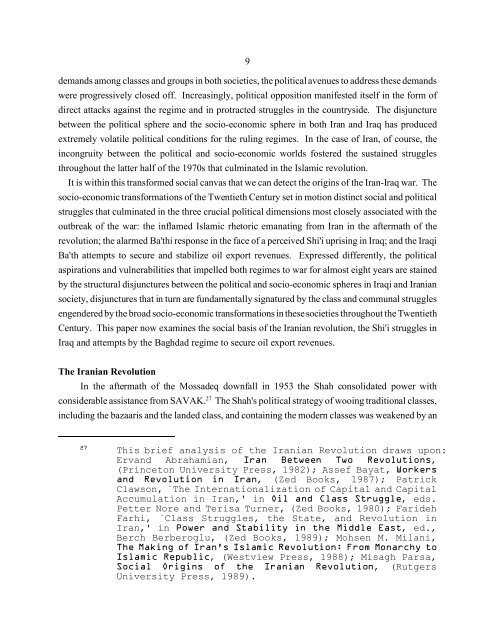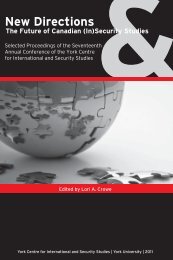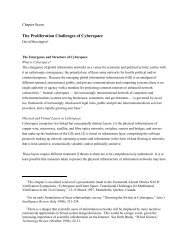THE SOCIAL ORIGINS OF THE IRAN-IRAQ WAR Thom Workman ...
THE SOCIAL ORIGINS OF THE IRAN-IRAQ WAR Thom Workman ...
THE SOCIAL ORIGINS OF THE IRAN-IRAQ WAR Thom Workman ...
Create successful ePaper yourself
Turn your PDF publications into a flip-book with our unique Google optimized e-Paper software.
9<br />
demands among classes and groups in both societies, the political avenues to address these demands<br />
were progressively closed off. Increasingly, political opposition manifested itself in the form of<br />
direct attacks against the regime and in protracted struggles in the countryside. The disjuncture<br />
between the political sphere and the socio-economic sphere in both Iran and Iraq has produced<br />
extremely volatile political conditions for the ruling regimes. In the case of Iran, of course, the<br />
incongruity between the political and socio-economic worlds fostered the sustained struggles<br />
throughout the latter half of the 1970s that culminated in the Islamic revolution.<br />
It is within this transformed social canvas that we can detect the origins of the Iran-Iraq war. The<br />
socio-economic transformations of the Twentieth Century set in motion distinct social and political<br />
struggles that culminated in the three crucial political dimensions most closely associated with the<br />
outbreak of the war: the inflamed Islamic rhetoric emanating from Iran in the aftermath of the<br />
revolution; the alarmed Ba'thi response in the face of a perceived Shi'i uprising in Iraq; and the Iraqi<br />
Ba'th attempts to secure and stabilize oil export revenues. Expressed differently, the political<br />
aspirations and vulnerabilities that impelled both regimes to war for almost eight years are stained<br />
by the structural disjunctures between the political and socio-economic spheres in Iraqi and Iranian<br />
society, disjunctures that in turn are fundamentally signatured by the class and communal struggles<br />
engendered by the broad socio-economic transformations in these societies throughout the Twentieth<br />
Century. This paper now examines the social basis of the Iranian revolution, the Shi'i struggles in<br />
Iraq and attempts by the Baghdad regime to secure oil export revenues.<br />
The Iranian Revolution<br />
In the aftermath of the Mossadeq downfall in 1953 the Shah consolidated power with<br />
considerable assistance from SAVAK. 27 The Shah's political strategy of wooing traditional classes,<br />
including the bazaaris and the landed class, and containing the modern classes was weakened by an<br />
27<br />
This brief analysis of the Iranian Revolution draws upon:<br />
Ervand Abrahamian, Iran Between Two Revolutions,<br />
(Princeton University Press, 1982); Assef Bayat, Workers<br />
and Revolution in Iran, (Zed Books, 1987); Patrick<br />
Clawson, `The Internationalization of Capital and Capital<br />
Accumulation in Iran,' in Oil and Class Struggle, eds.<br />
Petter Nore and Terisa Turner, (Zed Books, 1980); Farideh<br />
Farhi, `Class Struggles, the State, and Revolution in<br />
Iran,' in Power and Stability in the Middle East, ed.,<br />
Berch Berberoglu, (Zed Books, 1989); Mohsen M. Milani,<br />
The Making of Iran's Islamic Revolution: From Monarchy to<br />
Islamic Republic, (Westview Press, 1988); Misagh Parsa,<br />
Social Origins of the Iranian Revolution, (Rutgers<br />
University Press, 1989).





